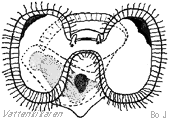|

|
|
|
A few microscopic eggs at a time are enclosed in small egg capsules
that drift around in the water. The eggs hatch after about a week
and small larvae appear and drift
around in the water and eat plankton. After about 3 weeks they
transform to a bottom living form and fall to the bottom in shallow
water.
|

|
Many are sterile
Many of the periwinkles are sterile because
of parasitic flatworms have injured the periwinkles intestines and genitals.
The parasites reproduce asexually in great numbers whilst eating the periwinkles,
but without directly killing them. The periwinkle is an intermittant host
for the parasites larvae. When the infected periwinkle is eaten by a gull,
the parasitic larvae have arrived at the end host, where adult parasites
develope and reproduce. The new larvae are then distributed along the
beach in bird droppings and thus infect more periwinkles along the shoreline.
Versitile
Large areas of the Baltic are far too
brackish to support a vigorous population that reproduces on a regular
basis. To the contrary, on the Swedish west coast, four specie of periwinkle
are common and reproduce annually. Three of these specie have no
pelagic larvae and are therefore relative stationary and reproduce
generation after generation within the same coastal area. Natural selection
forces adaption of these populations to the special circumstances that
pervail in just that local environment where they live - they are specialists.
The common periwinkle, because of its pelagic
larvae, is distributed over a much larger area, generation for generation.
This can result in the young periwinkles growing up in an environment
that is alien to that which their parents grew up in. Presumably, they
are able to survive the different and varying environments because they
have generalized characteristics that enable them to function in most
environments - they are versitile. Furthermore, they probably react to
varying signals in the environment in which they have ended up and grow
and therefore develope charcteristics that are compatible with the new
environment in which they live.
Bo Johannesson
|

|
Page
4 of 4
|
|
|